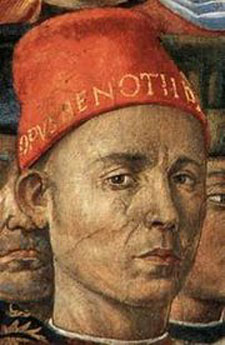| Benozzo Gozzoli  Born: 1420 Born: 1420
Birthplace: Florence, Italy
Died: 4-Oct-1497
Location of death: Pistoia, Italy
Cause of death: unspecified
Gender: Male
Religion: Roman Catholic
Race or Ethnicity: White
Occupation: Painter Nationality: Italy
Executive summary: Murals of the Campo Santo at Pisa Italian painter, born in Florence in 1424, or perhaps 1420, and in the early part of his career assisted Fra Angelico, whom he followed to Rome and worked with at Orvieto. In Rome he executed in Santa Maria in Aracoeli a fresco of "St. Anthony and Two Angels." In 1449 he left Angelico, and went to Montefalco, near Foligno in Umbria. In S. Fortunato, near Montefalco, he painted a "Madonna and Child with Saints and Angels", and three other works. One of these, the altar-piece representing "St. Thomas receiving the Girdle of the Virgin", is now in the Lateran Museum, and shows the affinity of Gozzoli's early style to Angelico's. He next painted in the monastery of S. Francesco, Montefalco, filling the choir with a triple course of subjects from the life of the saint, with various accessories, including heads of Dante, Petrarch and Giotto di Bondone. This work was completed in 1452, and is still marked by the style of Angelico, crossed here and there with a more distinctly Giottesque influence. In the same church, in the chapel of St. Jerome, is a fresco by Gozzoli of the Virgin and Saints, the Crucifixion and other subjects. He remained at Montefalco (with an interval at Viterbo) probably until 1456, employing Mesastris as assistant. From there he went to Perugia, and painted in a church a "Virgin and Saints", now in the local academy, and soon afterwards to his native Florence, the headquarters of art. By the end of 1459 he had nearly finished his important labor in the chapel of the Palazzo Riccardi, the "Journey of the Magi to Bethlehem", and, in the tribune of this chapel, a composition of "Angels in a Paradise." His picture in the National Gallery, London, a "Virgin and Child with Saints", 1461, belongs also to the period of his Florentine sojourn. Another small picture in the same gallery, the "Rape of Helen", is of dubious authenticity. In 1464 Gozzoli left Florence for S. Gimignano, where he executed some extensive works; in the church of S. Agostino, a composition of St Sebastian protecting the City from the Plague of this same year, 1464; over the entire choir of the church, a triple course of scenes from the legends of St. Augustine, from the time of his entering the school of Tagaste on to his burial, seventeen chief subjects, with some accessories; in the Pieve di S. Gimignano, the "Martyrdom of Sebastian", and other subjects, and some further works in the city and its vicinity. Here his style combined something of Lippo Lippi with its original elements, and he received cooperation from Giusto d'Andrea. He stayed in this city until 1467, and then began, in the Campo Santo of Pisa, from 1469, the vast series of mural paintings with which his name is specially identified. There are twenty-four subjects from the Old Testament, from the "Invention of Wine by Noah" to the "Visit of the Queen of Sheba to Solomon." He contracted to paint three subjects per year for about ten ducats each. It appears, however, that this contract was not strictly adhered to, for the actual rate of painting was only three pictures in two years. Perhaps the great multitude of figures and accessories was accepted as a set-off against the slower rate of production. By January 1470 he had executed the fresco of "Noah and his Family", followed by the "Curse of Ham", the "Building of the Tower of Babel" (which contains portraits of Cosmo de Medici, the young Lorenzo Politian and others), the "Destruction of Sodom", the "Victory of Abraham", the "Marriages of Rebecca and of Rachel", the "Life of Moses", etc. In the Cappella Ammannati, facing a gate of the Campo Santo, he painted also an "Adoration of the Magi", wherein appears a portrait of himself. All this enormous mass of work, in which Gozzoli was probably assisted by Zanobi Macchiavelli, was performed, in addition to several other pictures during his stay in Pisa (we need only specify the "Glory of St. Thomas Aquinas", now in the Louvre), in sixteen years, lasting up to 1485. This is the latest date which can with certainty be assigned to any work from his hand, although he is known to have been alive up to 1498. In 1478 the Pisan authorities had given him, as a token of their regard, a tomb in the Campo Santo. He had likewise a house of his own in Pisa, and houses and land in Florence. In rectitude of life he is said to have been worthy of his first master, Fra Angelico.
The art of Gozzoli does not rival that of his greatest contemporaries either in elevation or in strength, but is preeminently attractive by its sense of what is rich, winning, lively and abundant in the aspects of men and things. His landscapes, thronged with birds and quadrupeds, especially dogs, are more varied, circumstantial and alluring than those of any predecessor; his compositions are crowded with figures, more characteristically true when happily and gracefully occupied than when the demands of the subject require tragic or dramatic intensity, or turmoil of action; his color is bright, vivacious and festive. Gozzoli's genius was, on the whole, more versatile and assimilative than vigorously original; his drawing not free from considerable imperfections, especially in the extremities and articulations, and in the perspective of his gorgeously schemed buildings. In fresco painting he used the methods of tempera, and the decay of his works has been severe in proportion. Of his untiring industry the recital of his labors and the number of works produced are the most forcible attestation.
Do you know something we don't?
Submit a correction or make a comment about this profile
Copyright ©2019 Soylent Communications
|